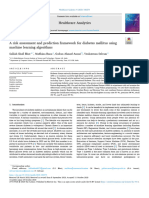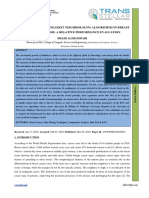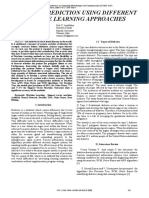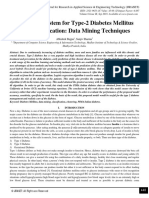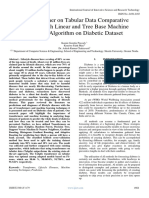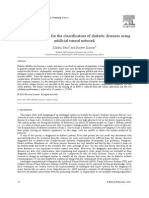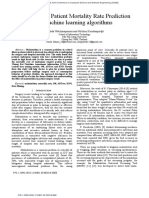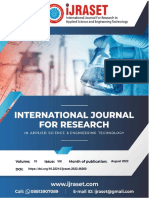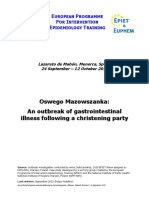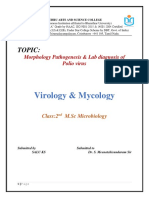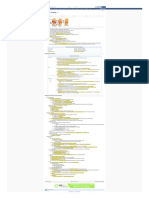Professional Documents
Culture Documents
Machine Learning Survival Analysis Model For Diabetes Mellitus
Original Title
Copyright
Available Formats
Share this document
Did you find this document useful?
Is this content inappropriate?
Report this DocumentCopyright:
Available Formats
Machine Learning Survival Analysis Model For Diabetes Mellitus
Copyright:
Available Formats
Volume 8, Issue 4, April 2023 International Journal of Innovative Science and Research Technology
ISSN No:-2456-2165
Machine Learning Survival Analysis Model
for Diabetes Mellitus
Maureen I. Akazue1, Geofrey A. Nwokolo1, Okpako A. Ejaita2 Clement O. Ogeh1 Emmanuel Ufiofio1,
1
Department of Computer Science, Delta State University, Abraka, Nigeria
2
Department of Cyber Security, University of Delta, Agbor*
Abstract:- Developing effective survival analysis models alternate action that affects the life of patients receiving
would help guide the decision-making in managing treatment is required[8, 9 & 10].However, to respond to this
major health challenges. Model development can be need, many studies have concentrated on prediction models
achieved through various approaches. Diabetes is a in traditional techniques, but computer scientists have
health challenge in Nigeria that has attracted the interest focused on it using machine learning methodologies, to
of researchers thus much research has been carried out construct prediction models [11, 12].
as regards its management necessitating the
development of models. This study carried out a machine Machine learning has played a great role in survival
learning analysis on diabetes data collected from Central analysis helping out in clinical forecasting. Work done in
Hospital, Warri, Delta State implementing Cox-PH this area includes “machine learning for survival analysis: a
Model due to the role both play in survival analysis. A case study on recurrence of prostate cancer” [13],
dataset of 100 diabetic patients' records was collected. “ComoRbidity: an R package for the systematic analysis of
The dataset was used for training multiple machine disease comorbidities”[14], “Survival model for Diabetes
learning algorithms, namely, SupportVector (SVM), K- Mellitus Patients’ using support vector machine”[15], etc.
nearestneighbors (KNN) classifier, etc., and the proposed This field has drawn much attention in the past and has
model (Cox-PH Hybrid or CPH-SML). The performance become a dominant technology in the AI community [16].
evaluation of the machine learning algorithms and the
Survival Analysis is one of the most popular methods
proposed model gave accuracy levels as follows: KNN-
47%, SVM; 74%, and Cox-PH Hybrid-96%. The of data mining that deals withthe estimation of the time to an
event such as death, childbirth, radioactive decay, etc [3, 17,
concordance index was used to evaluate the proposed
18 & 19].
model and it had an index of 0.7204, on several
covariates such as Age, Gender, Education, Marital Due to the increasing rate of DM in the world, there
Status, history of smoking, SBP, DBP, etc. From this arises the needfor more medical attention.One area which
study's analysis of the diabetic data, it was able to has responded to such need is the area of developing
conclude that the variables associated with diabetes survival analysis models by researchers using machine
mortality are; the age of the patient and diabetes types. learning algorithms. One algorithm in Machine learning is
The patients' hazard ratio reduces when they are young the Support Vector Machine algorithm used in a recent
compared to when they are old. The patient's hazard study for survival analysis on DM patients in Nigeria
ratio is also dependent on the diabetes type. Thus, early [20].This algorithm is said to be a fault in the area of
diagnosis and proper health management of diabetics handling large datasets for analysis. This, therefore calls for
can prolong the age of diabetic patients. development of an enhanced model for diabetes survival
Keywords:- Survival Model, Machine Learning, Cox analysis. This study developed a survival analysis model
Proportional Hazard, Diabetes. using a machine learning algorithm for diabetes mellitus
patients while implementing the Cox Proportional Hazard
I. INTRODUCTION model. Dataset for diabetes data was collected from Central
Hospital in Delta State of Nigeria.
Diabetes patients are increasing at a rapid rate, and it is
estimated that more than 90-95 percent of people globally II. RELATED WORKS
have Type 2 diabetes, which is one of the leading causes of
death and contributes to a large number of deaths each year Several models have been built to solve different
in an unnoticed manner [1]. Diabetes Mellitus (DM) has human problems. These problems ranges from customers
been defined as a condition that is induced by unregulated challenges at airport, performing online transactions,
diabetes that may lead to multi-organ failure in patients [2]. advisory systems, intrusion detection systems, and so
Diabetes has become one of the biggest health challenges in onOkpeki et al.[21]; Okofu[22]; Okpeki & Omede[23];
the world hence the need to control and manage it. Okofu et al. [24]; Efozia et al. [25]; Akazue[26]; Oijoe [27];
Ojugo&Otakore [28]; Ojugo& Yoro [29].Thus, it is good to
Related works in the healthcare information systems provide survival models for health challenges. A survival
show that the increasing number of healthcare data requires model to predict the survival of pediatric Sickle Cell Disease
the need for effective means of extracting information to aid (SCD) was developed using clinical variables by Idowu et
the delivery of healthcare services to patients [3,4,5,6& 7]. al., [30]. The predictive model works with fuzzy logic.Three
The development of a prediction model to guide clinical (3) clinical variables were used and the rules for the
decisions about whether to continue therapy or take an inference engine were elicited from an expert pediatrician
IJISRT23APR586 www.ijisrt.com 754
Volume 8, Issue 4, April 2023 International Journal of Innovative Science and Research Technology
ISSN No:-2456-2165
[31]. The study report on the non-validation of the fuzzy compare it to the expected life expectancyof persons living
logic-based model using live clinical datasets.Furthermore, without diabetes in the country.Analysis of confounders
relevant variables for SCD survival could have been easily wasdone by age, sex, and type of diabetes. The causes of
identified using feature selection methods from a larger mortality in diabetic patients were analyzed by making use
collection of variables monitored for pediatric SCD survival of Kaplan-Meier survival curves for each age cluster. Lon-
as observed, but the study found that the researchers did rank analysis was not also left out. Findings in the study
simulate nor validate the rule-base of the classification include; male diabetics patients showing slightly longer life
model for SCD survival [32]. expectancy than their counterparts in the non-diabetic
population, by a marginal gain of 0.6 years for the entire
Machine learning was applied to the prediction of the observed period. Furthermore, life expectancy indiabetic
survival of pediatricHIV/AIDS patients [33]. The naïve women was said to increaseby 1.3 years, which was not
Bayes’ classifier was employed. The model was trained, observed in the non-diabetic population. Diabetes was said
evaluated, and gave a result that showed that the classifier to occur more in women.
was able to predict the survival of HIV/AIDS patients by the
model's accuracy of 68%. The Support Vector Machine was used by Bamidele et
al., [38] to develop a survival model for diabetes mellitus.
A pilot study on type 2 diabetes patients, showed the Identification of variables monitored during the
use of Deep learning to develop a novel adherence management of diabetes mellitus patients was done.
detection. This was based on simulated Continuous Glucose
Monitoring (CGM) signals. CGM signals were simulated in Lee et al., [39] did work in Hong Kong with the aim of
a large and diverse amount for T2D patients with the aid of developing a predictive risk modelfor all-cause mortality in
a T2D-adapted version of the Medtronic Virtual Patient patients with diabetes. The study used a multi parametric
(MVP) model for T1D [34]. Due to the signals, different approach with data from different domains. The association
classification algorithms were compared using a of risk variables and all-causemortality was assessed using
comprehensive grid search. The researchers for the study Cox proportionalhazardsmodels. Machine learning
contrasted a standard logistic regression baseline to Multi- approaches were used in the study to improve overall
Layer Perceptrons (MLPs) and Convolutional Neural survival prediction and were evaluatedwith a fivefold cross-
Networks (CNNs). It was reported that the best validation method. Age, male gender, baseline
classification performance having an average accuracy of comorbidities, etc were significant predictors of all-cause
77:5% came as a result of employing CNN. This study, mortality found through Multivariate Cox regression. The
therefore, confirms the potential of Deep Learning as study affirms that a multi parametric model incorporating
regards adherence detection systems for Type 2 disease variables from different domains predicted all-cause
patients [34]. mortality accurately in type 2 diabetes mellitus.
Predicting factors for the survival of breast cancer Survival analysis has also been done on coronavirus
patients using machine learning techniques was done in patients with the introduction of two models called
2019. The study developed models for detecting and Cox_COVID_19 and Deep_ _Cox_COVID_19. These
visualizing significant prognostic indicators of breast cancer models were developed to help hospitals select patients with
survival rate [35]. The datasets were a hospital-based breast better chances of survival and to predict the most important
cancer dataset from the University of Malaya Medical features affecting the rate of survival [39]. One of the
Centre, Kuala in Malaysia with diagnostic information survival models; Cox_COVID_19 is based on Cox
between 1993 and 2016. To determine the predicting regression while the second model; Deep_Cox_COVID_19
factors, models were developed with a decision tree, random is a hybrid model, i.e a combination of autoencoder deep
forest, neural networks, extreme boots, logistic regression, neural network and Cox regression. The study affirms that
and support vector machine. The study affirms that all both systems (i.e the Cox_COVID_19 and Deep_
algorithms produced close outcomes, with the lowest Cox_COVID_19) can predict the survival likelihoodand
obtained from the decision tree (accuracy = 79.8%) and the also present significant symptoms that differentiate severe
highest from the random forest (accuracy = 82.7%). cases and death cases.
More work done on breast cancer survival Ojie, et al., [41] applied classification algorithm in
includesKalafi et al., [36] using 4,902 patient records from their proposed hybrid model of Genetic Algorithm and Data
the University of Malaya Medical Centre Breast Cancer value Metric (DVM) as an information theoretic metric for
Registry (UMMCBCR).The prediction modelswere quantifying the quality and utility for feature selection. They
designed and implemented by machine learning(SVM, RF, proposed that this can be applied to traditional data.
and DT) and deep learning MLP techniques.Findings show
that the multilayer perceptron (MLP),random forest (RF)
and decision tree (DT) classifierscould predict survivorship,
respectively, with 88.2 %, 83.3 %, and 82.5 % accuracy in
the tested samples. And Support vector machine (SVM) was
recorded lower with 80.5 %.
Tachkov et al.,[37] conducted a study to evaluate the III. METHODS AND MATERIALS
expected life expectancy in patients with diabetes and to
IJISRT23APR586 www.ijisrt.com 755
Volume 8, Issue 4, April 2023 International Journal of Innovative Science and Research Technology
ISSN No:-2456-2165
To carry out survival analysis and develop a predictive The diabetes data were recorded using a spreadsheet with
model on diabetes mellitus using a machine learning the assistance of the health workers in the unit. Most of the
algorithm, the following steps were adopted (i) Data features relating to diabetes that needed to be collected for
collection, (ii) Data preparation, (iii) Implementing the the study were outlined by medical personnel that the
proposed model, and (iv)Evaluation. researcher contacted.
A. Data Collection
After ethical approval, the researcher collected various Features relating to the survival or mortality of
variables from the records of 100 diabetes patients from the diabetes mellitus patients were collected from the Hospital.
state central Hospital, Warri-Delta State following due Table 1 below is a description of the variables collected and
procedures for collecting patient data in the health facility. used for the proposed system.
Table 1: Identified Variables for determining Diabetes Mellitus
S/N Names of Variables Labels
1 Gender Male, Female
2 Present Age (in years) Numeric
3 Highest Education Primary, Secondary, Tertiary, Others, Nil
4 Occupation Business, Civil Servant, Teacher, Electrician, Trader, Carpenter, Farmer, Cleaner, Nil
5 Marital Status Single, Married, Widow, Widower, Divorced
6 Ethnicity Urhuoba, Yoruba, Igbo, Hausa, Itsekiri, Ijaw
7 History of Smoking Yes, No
8 Diabetes Type Type 1, Type 2, Gestational
9 Age at Diagnosis (in years) Numeric
10 Systolic Blood Pressure (SPB) Numeric
11 Diastolic Blood Pressure (DPB) Numeric
12 BMI Class Underweight, Normal, Overweight, Obese
13 Haemoglobin A1c Numeric
14 Treatment Plan Insulin, others
15 History of Drug Resistance Yes, No
16 Complication Neuropathy, Nephropathy, Retinopathy, CVD, Stroke, Peripheral Artery Disease
17 Mortality Numeric
B. Data Preparation IV. IMPLEMENTING THE PROPOSED MODEL
After the collection of data, the data was analyzed and
cleaned. This means that data necessary for use in the A. Data Training and Learning
various machine-learning algorithms were processed. The The datasets are prepared for training and learning the
process involved the following: features of the datasets using the various machine learning
The ethnicity (Tribe) column was dropped. methods, including Random Forest, Gradient Boosting,
Yes / No type of columns were respectively converted and Decision Tree, Support Vector, Multi-Layer Perceptron, and
cleaned. K-nearest Neighbors' classifier. During the training process,
Single observation on target variable value was found to the model makes an effort to comprehend the properties and
be missing and hence dropped. instance representation of a certain dataset that is used as
Missing observations on a few categorical columns were input. The text input is converted by the feature extractor
into a feature vector that categorizes its polarity. The
detected and thus filled with their respective column mode
programmer chose to divide the datasets into two halves for
value.
this investigation, with the ratio being 80% to 20% for
All the categorical features were one-hot encoded.
training and learning, respectively. The training data is
All the values in the dataset were scaled between 0 and 1 represented using the attributes after the instance and
as a standardization technique. attributes have been chosen.
Dataset was split into training and testing sets ina ratio of
80:20. B. Data Testing and Classification
An extreme imbalance was detected on the target The output of the training datasets was compared with
variablein the ratio of 85:14. It was handled by that of the testing datasets in order to check all conceivable
applyingSynthetic Minority Oversampling Technique combinations and evaluate how effectively a model will
(SMOTE). predict the intended or expected results. Were the expected
result far different from the output result, the input was
The stepwise variable feature selection with iteration adjusted and the model was fine-tuned based on the results
between the ‘forward and backward’ steps to obtain the best of the test data set. This was accomplished by comparing the
patient final Cox proportional hazard model was then attributes of the training and testing datasets, computing the
implemented, tested, and evaluated for optimum probability for each hypothesis based on the attributes, and
performance. categorizing the attributes that were most similar to the
outcome. Then Real-world datasets were then fed into the
classifier for the categorization of tweets and spam emails
IJISRT23APR586 www.ijisrt.com 756
Volume 8, Issue 4, April 2023 International Journal of Innovative Science and Research Technology
ISSN No:-2456-2165
while taking into account all of the classifying methods algorithms. Then, a model with Random Forest Classifier
either as a single selection or bulk selection. First, the and Cox Proportional Hazard algorithm was then developed
classifier is fed with testing datasets to check the correctness with the title CPH-MLS Prediction model and deployed to
of the algorithm. the web app with a model performance accuracy of 96%.
C. Building the Model From the fitted COX PH Model the variables that are
Multiple models were trained, namely, Random Forest, associated with the mortality are the age of the patient,
Gradient Boosting, DecisionTree, Support Vector, Multi- diabetes, and education level. The patients' hazard ratio
Layer Perception, and K-nearest neighbors' classifier. The increases by 1.95 when they have secondary education
Cox proportionality Hazards model was also implemented compared to when they have primary education. The
and evaluated on the dataset. This model was introduced by patients' hazard ratio reduces by 0.96 when they are young
Cox and takes into account the effect of several variables at compared to when they are old. The patients' hazard ratio
a time and the relationship of their survival distribution to reduces by 0.53 when they have diabetes compared to when
these variables. The Random Forest algorithm yielded the they have no diabetes.
best result with an accuracy of 82% against other
Fig. 1: Graph of Model prediction
The above chart shows the usability of the model in D. Evaluation
predicting the probability of having diabetes or not and the The performance metrics were used to evaluate the
survival time of new patients. Thus the chart gives the performance of the various algorithms in this study. This
survival time and probability. On the left is the prediction, 0, gives the overall performance summary of the learning
1. When the chart reads 1, it means that it is predicting algorithms on the datasets and weighted (average)
possible cases of diabetes mortality for the patient record performance rate which is shown below in table 2, fig 2, and
analyzed and when it reads 0, it indicates no diabetes fig 3.
mortality prediction.
Table 2: Summary of Model Performance
Model Precision Recall F1-Score Accuracy
0.45 0.56 0.5 47%
KNN
0.5 0.4 0.44
0.62 0.56 0.59 63%
Logistic
0.64 0.7 0.67
1 0.44 0.62 74%
SVM
0.67 1 0.8
0.93 1 0.96 96%
Cox-PH Hybrid
0.96 0.96 0.96
IJISRT23APR586 www.ijisrt.com 757
Volume 8, Issue 4, April 2023 International Journal of Innovative Science and Research Technology
ISSN No:-2456-2165
ACCURACY CHART
100
80
KNN
60
Logistic
40 SVM
20 Cox-PH Hybrid
0
Accuracy
Fig. 2: Accuracy Performance Analysis on Diabetes Datasets
0.98
1
0.9
0.8 0.72
0.7 0.63
Precision
0.6
0.48
0.5 Recall
0.4
F1-Score
0.3
0.2
0.1
0
KNN Logistic SVM Cox-PH Hybrid
Fig. 3: Precision, Recall Value, and F-Measure Analysis on Diabetes Datasets
V. RESULT AND DISCUSSION The patient’s hazard ratio reduces by 0.53 when they have
diabetes compared to when they have no diabetes.
To perform the survival analysis of diabetes mellitus,
this study has developed a hybrid model of implementing VI. CONCLUSION
the Random Forest algorithm Cox-PH. From the
performance and evaluation of the designed model, this The study has been able to establish that a machine
study has shown that the integration of Machine Learning learning model for survival analysis and prediction can be
and the Cox-proportional hazard model in survival analysis implemented along parameter or non-parameter tools for
is achievable. The result of the model on the dataset showed modeling time-to-event data. This is because machine
that the variables that are associated with diabetes mortality learning tools and algorithms and efficient in building
are; the age of the patient and diabetes types. The study prediction and analysis models.
shows that patients' hazard ratio reduces by 0.96 when they
are young compared to when they are old. The patient's REFERENCES
hazard ratio reduces by 0.53 when they have diabetes [1.] S. I. Ayom and I. Milon, “Diabetes Prediction: A
compared to when they have no diabetes. Deep Learning Approach. I.J. Information
Evaluating the algorithm’s predictions using a statistic Engineering and Electronic Business, Vol2, pp.21–
tool known as the concordance index or c-index on the Cox- 27, 2019.
PH concordance Index for the models with several [2.] J. Chaki, S.T. Ganesh, S. K. Cidham and S. A.
covariates the best model with increasing index was used Theertan, “Machine learning and artificial
and deployed. The result from the fitting of the CoxPH intelligence-based Diabetes Mellitus detection and
model on the dataset shows that the variables that are self-management: A systematic review, Journal of
associated with diabetes mortality are; the age of the patient King Saud University – Computer and Information
and diabetes types. The patients' hazard ratio reduces by Sciences, volxxx, no. xxxx, pp. 1–22, 2020.
0.96 when they are young compared to when they are old.
IJISRT23APR586 www.ijisrt.com 758
Volume 8, Issue 4, April 2023 International Journal of Innovative Science and Research Technology
ISSN No:-2456-2165
[3.] E. U. Omede, “Optimization of determinant Bioinformatics, vol8, no. 2, pp.52–61.
diagnostic symptoms for Febrile Diseases using https://doi.org/10.11648/j.cbb.20200802.14, 2020.
Genetic Algorithm”, Communication in Physical [16.] J. Xie, Y, Liu, X Zeng, W. Zhang and Z. Mei, “A
Sciences, vol. 8 no. 4, pp. 556 – 572, 2022. Bayesian network model for predicting type 2
[4.] I. Ajenaghughrure, P. Sujatha, and A. Maureen, diabetes risk based on electronic health records,
“Fuzzy based multi-fever symptom classifier Modern PhysLett B, vol 31, pp.31-21, 2017.
diagnosis model”, International Journal of [17.] M. Akazue and N.F. Efozia, “A Review of
Information Technology and Computer Science, vol Biometric Technique for Securing
9, no. 10, pp 13 – 28, DOI: 10.5815/ijitcs.2017. Corporate Stored Data,” Software Engineering
[5.] B. O. Ojeme and M. Akazue, “Human and Intelligent Systems, vol. 1, pp. 329- 342,
immunodeficiency virus (HIV) diagnosis using 2010.
Neuro-Fuzzy Expert System”, Orient. J. Comp. Sci. [18.] B. Ojeme, M. Akazue and E. Nwalih, “Automatic
and Technol., vol. 7, no. 2, pp 207 – 218, 2014. Diagnosis of Depressive Disorders using Ensemble
[6.] E. Domingos, B. Ojeme and O. Daramola, Techniques”, African Journal of Computing & ICT,
“Experimental analysis of Hyper-parameters for 2016.
Deep Learning-based Churn prediction in the banking [19.] E. E. Abel, Ubiquitous computing: An assistive
sector”, Computation, vol. 9, no. 3, 2021. surveillance on in and out patients with mental
[7.] B. Ojeme and A. Mbogho, “Selecting learning illness via RFID”, British Journal of Mathematics &
algorithms for simultaneous identification of Computer Science, vol. 17, no. 3, pp 1-15, 2016.
depression and comorbid disorders, Procedia [20.] P. A. Idowu, O. Agbelusi and T. A. Aladekomo, “The
Computer Science, vol. 96, pp 1294 – 1303, Prediction of Pediatric HIV/AIDS Patients’ Survival:
2016. A Data Mining Approach”,Asian Journal of
[8.] A. O. Amoo, T. O. Oyegoke, J. A. Balogun, S. A. Computer and Information Systems, vol4, no 3, pp.
Bamidele and P. A. Idowu, “Survival Model for 287–294, 2016.
Diabetes Mellitus Patient Receiving [21.] U. K.Okpeki, A. S.Adegoke and E. U.Omede,
Treatment”,International Journal of Computers, “Application of Artificial Intelligence for Facial
Vol5,pp 1–13, 2020. Accreditation of Officials and Students for
[9.] S.C. Chiemeke and E.U. Omede, “Mal-Typho Examinations”,FUPRE Journal of Scientific and
Diagnosis intelligent system (MATDIS): The Industrial Research, vol. 6, no 3, pp 01 – 11, 2022.
Auto-diagnostic rule generation algorithm”, vol. 5, [22.] S. N. Okofu, “Users service quality trust perception
no. 4, 2014. of online hotel room reservation”, SAU Journal of
[10.] T. Agbele, B. Ojeme and R. Jiang, “Application of Management and Social Sciences, vol 3, no. 1&2, pp.
local binary patterns and cascade AdaBoost 1-14.
classifier for mice behavioural patterns detection and [23.] U.K. Okpeki and E. U. Omede, “ Design and
analysis”, Procedia Computer Science, vol. 159, pp implementation of auto tech resource sharing system
1375 – 1386, 2019. for secondary schools in Delta State”, Journal of the
[11.] A. Alessandro and S. Stefano, “Information dropout: Nigerian Association of Mathematical
Learning optimal representations through noisy Physics, vol. 51, pp 325 – 332.
computation”,IEEE Transactions on Pattern Analy- [24.] N. F. Efozia, S. O. Anigbogu and K.S. Anigbogu,
Sis and Machine Intelligence, vol40, no. 12, 2897– “Development of a hybrid model for enhancing data
2905, 2018. integration process of business intelligence”, Journal
[12.] M. Akazue, O. Ovoh, A. E. Edje, C. O. Ogeh and A. of Basic Physical Research, vol. 9, no. 2, pp 1-16,
C. Hampo-JohnPaul, “An Enhanced Model for the 2019.
Prediction of Cataract Using Bagging Techniques”, [25.] M. I. Akazue and I. B. Ajenaghughrure, "Virtual
International Journal of Innovative Science Examination Supervision System for Nigerian
and Research Technology,vol 8, no. 2, pp 220-227, Universities", International Journal of Modern
2023. Education and Computer Science (IJMECS), vol.
[13.] B. Zupan, J. Demsar, M.W. Kattan, J.R. Beck and I. 8, no. 9, pp. 43-50, 2016.
Bratko, “Machine learning for survival analysis: a [26.] M. Akazue, “Enhanced hotel management
case study on recurrence of prostate cancer”, information system for multiple reservation
Artificial Intelligence in Medicine, Vol 20, pp. 59-75, booking”, Int. Manag. Rev., vol. 12, no. 1, pp 52,
2000. 2016.
[14.] A. Gutierrez-Sacristan, A. Bravo, A. Giannoula, M.A. [27.] U. Oijoe, “Authenticated and dynamic website: A
Mayer, F. Sanz and L.I. Furlong, “comorbidity: sure control against website spoofing attacks”,
an R package for the systematic analysis of disease Journal of Software Engineering and Simulation, vol.
comorbidities, Bionformatics, vol 34, no. 18, pp. 9, no. 3, pp 57-60, 2023.
3228 – 3230. [28.] A.A. Ojugo and D.O. Otakore, “Intelligent cluster
[15.] S. A. Bamidele, A. Asinobi, N. C. Egejuru and P. A. connectionist recommender system using implicit
Idowu, “Survival Model for Diabetes Mellitus graph friendship algorithm for social networks”, Int.
Patients’ Using Support Vector Journal of Artificial Intelligence,vol. 9, no.
Machine”,Computational Biology and
IJISRT23APR586 www.ijisrt.com 759
Volume 8, Issue 4, April 2023 International Journal of Innovative Science and Research Technology
ISSN No:-2456-2165
3: pp497~506, doi: 10.11591/ijai.v9.i3.pp497~506, [39.] D. V. Ojie, M. I. Akazue and A.Imianvan, “A
2020. Framework for Feature Selection using Data
[29.] A.A. Ojugo. And R. Yoro.,”Forging deep learning Value Metric and Genetic Algorithm”, International
neural network intrusion detection framework to Journal of Computer Applications, vol 184, no. 43,
curb the distributed denial of service attack”, pp. 097-8887, 2023.
International Journal of Electrical and Computer
Engineering, vol. 11, no. 2, pp 1498-1509, 2021.
[30.] P. A. Idowu, T. A. Aladekomo, K.O. Williams and J.
A. Balogun, “Predictive Model for Likelihood of
Sickle Cell Anemia (SCA) among Pediatric Patients
using Fuzzy Logic”,Transactions in Networks and
Communications, vol31, no 1, pp. 31–44, 2015.
[31.] A. O. Amoo, T. O. Oyegoke, J. A. Balogun, S. A.
Bamidele and P. A. Idowu, “Survival Model for
Diabetes Mellitus Patient Receiving
Treatment”,International Journal of Computers,
Vol5,pp 1–13, 2020.
[32.] P. A. Idowu, O. Agbelusi and T. A. Aladekomo, “The
Prediction of Pediatric HIV/AIDS Patients’
Survival: A Data Mining Approach”,Asian Journal of
Computer and Information Systems, vol4, no 3,
pp. 287–294, 2016.
[33.] A. Mohebbi, T. B. Aradóttir, A. R. Johansen, H.
Fraccaro and M. Mørup, “A deep learning approach
to adherence detection for type 2 diabetics”39th
Annual International Conference of the IEEE
Engineering in Medicine and Biology Society
(EMBC)IEEE Engineering in Medicine and Biology
Society (EMBC),Jeju, Korea (South).
https://doi.org/10.1109/EMBC.2017.8037462, 2017.
[34.] M. D. Ganggayah, N. A. Taib, Y. C. Har,P.Lio, and
S. K.Dhillon, “Predicting factors for survival of
breast cancer patients using machine learning
techniques”, BMC Medical Informatics and
Decision Making, vol 19, no. 48, pp. 1-17, 2019.
[35.] E. Y. Kalafi,N. A. M. Nor,N. A.Taib,M. D.
Ganggayah,C.Town and S. K.Dhillon,
“Machine Learning and Deep Learning Approaches
in Breast Cancer Survival Prediction Using Clinical
Data”, Folia Biologica (Praha),vol 65, pp. 212-220,
2019.
[36.] K. Tachkov, K. Mitov, Y. Koleva, Z. Mitkova, M.
Kamusheva, M. Dimitrova, V. Petkova, A. Savova,
M. Doneva et al., “Life expectancy and survival
analysis of patients with diabetes compared to the
non diabetic population in Bulgaria”,PLoS ONE, vol
15, no. 5, pp. 1-16, 2020.
[37.] S. Lee, J. Zhou, K. S. K. Leung,W. K. K. Wu,W. T.
Wong, T. Liu, I. C. K. Wong, K. Jeevaratnam, Q.
Zhang and G.Tse, “Development of a predictive risk
model for all-cause mortality in patients with diabetes
in Hong Kong”, BMJ Open Diabetes Research &
Care, vol 9, pp. 1-12, 2021.
[38.] M.Atlam,H.Torkey,N.El-Fishawy and H. Salem,
“Coronavirus disease 2019 (COVID- 19): Survival
analysis using deep learning and Cox regression
model”, Pattern Analysis and Applications, vol
24, 2021.
IJISRT23APR586 www.ijisrt.com 760
You might also like
- Research ProposalDocument13 pagesResearch Proposalsaby aroraNo ratings yet
- 11-A Risk Assessment and Prediction Framework For Diabetes Mellitus Using Machine Learning AlgorithmsDocument12 pages11-A Risk Assessment and Prediction Framework For Diabetes Mellitus Using Machine Learning Algorithmsbeefypixel761No ratings yet
- KNN Diabetes Internasional 2Document6 pagesKNN Diabetes Internasional 2Rizka YuliNo ratings yet
- Predictive Machine Learning Applying Cross Industry Standard Process For Data Mining For The Diagnosis of Diabetes Mellitus Type 2Document14 pagesPredictive Machine Learning Applying Cross Industry Standard Process For Data Mining For The Diagnosis of Diabetes Mellitus Type 2IAES IJAINo ratings yet
- Machine Learning Approach For Predicting Heart and Diabetes Diseases Using Data-Driven AnalysisDocument8 pagesMachine Learning Approach For Predicting Heart and Diabetes Diseases Using Data-Driven AnalysisIAES IJAINo ratings yet
- 1 s2.0 S2214785321052202 MainDocument4 pages1 s2.0 S2214785321052202 MainTusher Kumar SahaNo ratings yet
- 2 3 1646224428 2ijcnwmcjun20222Document10 pages2 3 1646224428 2ijcnwmcjun20222TJPRC PublicationsNo ratings yet
- Paper 1Document13 pagesPaper 1Michael JamesNo ratings yet
- Machine Learning Solutions Applied To Amyotrophic Lateral Sclerosis Prognosis: A ReviewDocument12 pagesMachine Learning Solutions Applied To Amyotrophic Lateral Sclerosis Prognosis: A ReviewJoel ArraisNo ratings yet
- IEEE Paper 1Document5 pagesIEEE Paper 1THEJASWINI V ANo ratings yet
- BE Project13Document4 pagesBE Project13Sanjana PolNo ratings yet
- Diabetic Prediction System Using Data Mining: September 2016Document8 pagesDiabetic Prediction System Using Data Mining: September 2016Mariem SelmiNo ratings yet
- Heart Disease Risk Prediction Using Deep Learning Techniques With Feature AugmentationDocument15 pagesHeart Disease Risk Prediction Using Deep Learning Techniques With Feature Augmentationharshitvashisth76No ratings yet
- An Expert System For Type-2 Diabetes Mellitus Risk Stratification: Data Mining TechniquesDocument13 pagesAn Expert System For Type-2 Diabetes Mellitus Risk Stratification: Data Mining TechniquesIJRASETPublicationsNo ratings yet
- Covid19 Prediction Model With Hybrid Approach A ReviewDocument6 pagesCovid19 Prediction Model With Hybrid Approach A ReviewIJRASETPublicationsNo ratings yet
- Prediction of Diabetes Empowered With Fused Machine Learning PDFDocument10 pagesPrediction of Diabetes Empowered With Fused Machine Learning PDFBhuvana SenthilkumarNo ratings yet
- Classification of Diabetes Disease Using Support Vector MachineDocument6 pagesClassification of Diabetes Disease Using Support Vector MachineTracker DeathNo ratings yet
- Type 2 Diabetes Mellitus Prediction Model Based On Data MiningDocument8 pagesType 2 Diabetes Mellitus Prediction Model Based On Data Mininglogu_thalirNo ratings yet
- Machine Learning Prediction of Coronary Heart DiseaseDocument6 pagesMachine Learning Prediction of Coronary Heart DiseaseNowreen HaqueNo ratings yet
- A Deep Learning Approach Based On Convolutional - 2020 - Computational BiologyDocument10 pagesA Deep Learning Approach Based On Convolutional - 2020 - Computational BiologyAndre Van ZylNo ratings yet
- Tarp FinalDocument24 pagesTarp FinalNamrata SinghalNo ratings yet
- CKD Stage Prediction and Suitable Diet Recommendation A SurveyDocument6 pagesCKD Stage Prediction and Suitable Diet Recommendation A SurveyIJRASETPublicationsNo ratings yet
- A Transformer On Tabular Data Comparative Analysis With Linear and Tree Base Machine Learning Algorithm On Diabetic DatasetDocument6 pagesA Transformer On Tabular Data Comparative Analysis With Linear and Tree Base Machine Learning Algorithm On Diabetic DatasetInternational Journal of Innovative Science and Research TechnologyNo ratings yet
- Survival Journal PaperDocument18 pagesSurvival Journal Papertoni tfnNo ratings yet
- Implementation of An Incremental Deep Learning Model For Survival Prediction of Cardiovascular PatientsDocument9 pagesImplementation of An Incremental Deep Learning Model For Survival Prediction of Cardiovascular PatientsIAES IJAINo ratings yet
- Decision Tree Discovery For The Diagnosis of Type II DiabetesDocument5 pagesDecision Tree Discovery For The Diagnosis of Type II DiabetesEka Panuju QuiñonesNo ratings yet
- Identification of Diabetes Disease From Human Blood Using Machine Learning TechniquesDocument7 pagesIdentification of Diabetes Disease From Human Blood Using Machine Learning Techniquessunilkumarkn26No ratings yet
- Prediction of Diabetes Using Logistics Regression Algorithms With FlaskDocument10 pagesPrediction of Diabetes Using Logistics Regression Algorithms With FlaskIJRASETPublicationsNo ratings yet
- Development of A Hybrid Dynamic Expert System For The Diagnosis of Peripheral Diabetes and Remedies Using A Rule Based Machine Learning TechniqueDocument10 pagesDevelopment of A Hybrid Dynamic Expert System For The Diagnosis of Peripheral Diabetes and Remedies Using A Rule Based Machine Learning TechniqueEditor IJTSRDNo ratings yet
- Machine Learning Classification for Diabetes DetectionDocument6 pagesMachine Learning Classification for Diabetes DetectionHoàng NamNo ratings yet
- Session 01 - Paper 07Document9 pagesSession 01 - Paper 07Nicholas DawsonNo ratings yet
- Projectreport Diabetes PredictionDocument22 pagesProjectreport Diabetes PredictionushavalsaNo ratings yet
- Machine Learning Predicts Metabolic SyndromeDocument4 pagesMachine Learning Predicts Metabolic SyndromeMd Mehedi Hasan RifatNo ratings yet
- SRI ReportDocument7 pagesSRI ReportDANI DJNo ratings yet
- Watcharapasorn 2016Document5 pagesWatcharapasorn 2016FranckNo ratings yet
- A Class Based Approach For Medical Classification of Chest PainDocument5 pagesA Class Based Approach For Medical Classification of Chest Painsurendiran123No ratings yet
- Data-Driven Approach To Age Prediction On Patients1Document16 pagesData-Driven Approach To Age Prediction On Patients1irfanabbasNo ratings yet
- BMC Medical Research MethodologyDocument12 pagesBMC Medical Research MethodologyAngie OsorioNo ratings yet
- Neural NetworkDocument15 pagesNeural NetworkAshish TiwariNo ratings yet
- applsci-12-03358Document18 pagesapplsci-12-03358nha8378No ratings yet
- Support Vector Machine: Machine Learning Approach in HealthcareDocument5 pagesSupport Vector Machine: Machine Learning Approach in HealthcareAnukul SrivastavaNo ratings yet
- Artificial Neural Network Classification Based Diabetes PredictionDocument9 pagesArtificial Neural Network Classification Based Diabetes PredictionIAEME PublicationNo ratings yet
- 8 1486792440 - 10-02-2017 PDFDocument5 pages8 1486792440 - 10-02-2017 PDFEditor IJRITCCNo ratings yet
- V8i5 1245Document4 pagesV8i5 1245Raunak SoniNo ratings yet
- Report DiabeticsDocument8 pagesReport DiabeticsBindhu NNo ratings yet
- An Examination and Evaluation of the Rising Incidence of Breast Cancer among Women and Impact on SocietyDocument5 pagesAn Examination and Evaluation of the Rising Incidence of Breast Cancer among Women and Impact on SocietyInternational Journal of Innovative Science and Research TechnologyNo ratings yet
- The Electronic Patient Diagnosis Management System in Naguru Teenage Information and Health CenterDocument21 pagesThe Electronic Patient Diagnosis Management System in Naguru Teenage Information and Health CenterKIU PUBLICATION AND EXTENSIONNo ratings yet
- Ijirt155579 PaperDocument4 pagesIjirt155579 PaperHarshana Reddy GillalaNo ratings yet
- An Efficient Deep Learning-Based Skin Cancer Classifier For An Imbalanced DatasetDocument16 pagesAn Efficient Deep Learning-Based Skin Cancer Classifier For An Imbalanced DatasetenthusiasticroseNo ratings yet
- Heart Disease rp5Document15 pagesHeart Disease rp5EkanshNo ratings yet
- Prediction of Diabetics Based On Machine LearningDocument8 pagesPrediction of Diabetics Based On Machine LearningInternational Journal of Innovative Science and Research TechnologyNo ratings yet
- Shti247 0386Document5 pagesShti247 0386Hema Latha Krishna NairNo ratings yet
- Predicting Diabetes in Medical Datasets Using Machine Learning TechniquesDocument14 pagesPredicting Diabetes in Medical Datasets Using Machine Learning TechniquesSardar Manikanta YadavNo ratings yet
- A Machine Learning Approach For Predicting Weight Gain Risks in Young AdultsDocument4 pagesA Machine Learning Approach For Predicting Weight Gain Risks in Young AdultsBen AllenNo ratings yet
- Diagnostics 11 01714 v2Document14 pagesDiagnostics 11 01714 v2Biswaranjan SwainNo ratings yet
- A Web Application For Predicting Chronic Kidney Diseases Using Machine LearningDocument13 pagesA Web Application For Predicting Chronic Kidney Diseases Using Machine LearningIJRASETPublicationsNo ratings yet
- V5i9 0240Document4 pagesV5i9 0240Nogo LumutenNo ratings yet
- Classification and Prediction of Disease Classes Using Gene Microarray DataDocument4 pagesClassification and Prediction of Disease Classes Using Gene Microarray DataIIR indiaNo ratings yet
- DiabetesPrediction ADeepLearningApproachDocument8 pagesDiabetesPrediction ADeepLearningApproachSINARASUNo ratings yet
- An Analysis on Mental Health Issues among IndividualsDocument6 pagesAn Analysis on Mental Health Issues among IndividualsInternational Journal of Innovative Science and Research TechnologyNo ratings yet
- Harnessing Open Innovation for Translating Global Languages into Indian LanuagesDocument7 pagesHarnessing Open Innovation for Translating Global Languages into Indian LanuagesInternational Journal of Innovative Science and Research TechnologyNo ratings yet
- Diabetic Retinopathy Stage Detection Using CNN and Inception V3Document9 pagesDiabetic Retinopathy Stage Detection Using CNN and Inception V3International Journal of Innovative Science and Research TechnologyNo ratings yet
- Investigating Factors Influencing Employee Absenteeism: A Case Study of Secondary Schools in MuscatDocument16 pagesInvestigating Factors Influencing Employee Absenteeism: A Case Study of Secondary Schools in MuscatInternational Journal of Innovative Science and Research TechnologyNo ratings yet
- Exploring the Molecular Docking Interactions between the Polyherbal Formulation Ibadhychooranam and Human Aldose Reductase Enzyme as a Novel Approach for Investigating its Potential Efficacy in Management of CataractDocument7 pagesExploring the Molecular Docking Interactions between the Polyherbal Formulation Ibadhychooranam and Human Aldose Reductase Enzyme as a Novel Approach for Investigating its Potential Efficacy in Management of CataractInternational Journal of Innovative Science and Research TechnologyNo ratings yet
- The Making of Object Recognition Eyeglasses for the Visually Impaired using Image AIDocument6 pagesThe Making of Object Recognition Eyeglasses for the Visually Impaired using Image AIInternational Journal of Innovative Science and Research TechnologyNo ratings yet
- The Relationship between Teacher Reflective Practice and Students Engagement in the Public Elementary SchoolDocument31 pagesThe Relationship between Teacher Reflective Practice and Students Engagement in the Public Elementary SchoolInternational Journal of Innovative Science and Research TechnologyNo ratings yet
- Dense Wavelength Division Multiplexing (DWDM) in IT Networks: A Leap Beyond Synchronous Digital Hierarchy (SDH)Document2 pagesDense Wavelength Division Multiplexing (DWDM) in IT Networks: A Leap Beyond Synchronous Digital Hierarchy (SDH)International Journal of Innovative Science and Research TechnologyNo ratings yet
- Comparatively Design and Analyze Elevated Rectangular Water Reservoir with and without Bracing for Different Stagging HeightDocument4 pagesComparatively Design and Analyze Elevated Rectangular Water Reservoir with and without Bracing for Different Stagging HeightInternational Journal of Innovative Science and Research TechnologyNo ratings yet
- The Impact of Digital Marketing Dimensions on Customer SatisfactionDocument6 pagesThe Impact of Digital Marketing Dimensions on Customer SatisfactionInternational Journal of Innovative Science and Research TechnologyNo ratings yet
- Electro-Optics Properties of Intact Cocoa Beans based on Near Infrared TechnologyDocument7 pagesElectro-Optics Properties of Intact Cocoa Beans based on Near Infrared TechnologyInternational Journal of Innovative Science and Research TechnologyNo ratings yet
- Formulation and Evaluation of Poly Herbal Body ScrubDocument6 pagesFormulation and Evaluation of Poly Herbal Body ScrubInternational Journal of Innovative Science and Research TechnologyNo ratings yet
- Advancing Healthcare Predictions: Harnessing Machine Learning for Accurate Health Index PrognosisDocument8 pagesAdvancing Healthcare Predictions: Harnessing Machine Learning for Accurate Health Index PrognosisInternational Journal of Innovative Science and Research TechnologyNo ratings yet
- The Utilization of Date Palm (Phoenix dactylifera) Leaf Fiber as a Main Component in Making an Improvised Water FilterDocument11 pagesThe Utilization of Date Palm (Phoenix dactylifera) Leaf Fiber as a Main Component in Making an Improvised Water FilterInternational Journal of Innovative Science and Research TechnologyNo ratings yet
- Cyberbullying: Legal and Ethical Implications, Challenges and Opportunities for Policy DevelopmentDocument7 pagesCyberbullying: Legal and Ethical Implications, Challenges and Opportunities for Policy DevelopmentInternational Journal of Innovative Science and Research TechnologyNo ratings yet
- Auto Encoder Driven Hybrid Pipelines for Image Deblurring using NAFNETDocument6 pagesAuto Encoder Driven Hybrid Pipelines for Image Deblurring using NAFNETInternational Journal of Innovative Science and Research TechnologyNo ratings yet
- Terracing as an Old-Style Scheme of Soil Water Preservation in Djingliya-Mandara Mountains- CameroonDocument14 pagesTerracing as an Old-Style Scheme of Soil Water Preservation in Djingliya-Mandara Mountains- CameroonInternational Journal of Innovative Science and Research TechnologyNo ratings yet
- A Survey of the Plastic Waste used in Paving BlocksDocument4 pagesA Survey of the Plastic Waste used in Paving BlocksInternational Journal of Innovative Science and Research TechnologyNo ratings yet
- Hepatic Portovenous Gas in a Young MaleDocument2 pagesHepatic Portovenous Gas in a Young MaleInternational Journal of Innovative Science and Research TechnologyNo ratings yet
- Design, Development and Evaluation of Methi-Shikakai Herbal ShampooDocument8 pagesDesign, Development and Evaluation of Methi-Shikakai Herbal ShampooInternational Journal of Innovative Science and Research Technology100% (3)
- Explorning the Role of Machine Learning in Enhancing Cloud SecurityDocument5 pagesExplorning the Role of Machine Learning in Enhancing Cloud SecurityInternational Journal of Innovative Science and Research TechnologyNo ratings yet
- A Review: Pink Eye Outbreak in IndiaDocument3 pagesA Review: Pink Eye Outbreak in IndiaInternational Journal of Innovative Science and Research TechnologyNo ratings yet
- Automatic Power Factor ControllerDocument4 pagesAutomatic Power Factor ControllerInternational Journal of Innovative Science and Research TechnologyNo ratings yet
- Review of Biomechanics in Footwear Design and Development: An Exploration of Key Concepts and InnovationsDocument5 pagesReview of Biomechanics in Footwear Design and Development: An Exploration of Key Concepts and InnovationsInternational Journal of Innovative Science and Research TechnologyNo ratings yet
- Mobile Distractions among Adolescents: Impact on Learning in the Aftermath of COVID-19 in IndiaDocument2 pagesMobile Distractions among Adolescents: Impact on Learning in the Aftermath of COVID-19 in IndiaInternational Journal of Innovative Science and Research TechnologyNo ratings yet
- Studying the Situation and Proposing Some Basic Solutions to Improve Psychological Harmony Between Managerial Staff and Students of Medical Universities in Hanoi AreaDocument5 pagesStudying the Situation and Proposing Some Basic Solutions to Improve Psychological Harmony Between Managerial Staff and Students of Medical Universities in Hanoi AreaInternational Journal of Innovative Science and Research TechnologyNo ratings yet
- Navigating Digitalization: AHP Insights for SMEs' Strategic TransformationDocument11 pagesNavigating Digitalization: AHP Insights for SMEs' Strategic TransformationInternational Journal of Innovative Science and Research TechnologyNo ratings yet
- Drug Dosage Control System Using Reinforcement LearningDocument8 pagesDrug Dosage Control System Using Reinforcement LearningInternational Journal of Innovative Science and Research TechnologyNo ratings yet
- The Effect of Time Variables as Predictors of Senior Secondary School Students' Mathematical Performance Department of Mathematics Education Freetown PolytechnicDocument7 pagesThe Effect of Time Variables as Predictors of Senior Secondary School Students' Mathematical Performance Department of Mathematics Education Freetown PolytechnicInternational Journal of Innovative Science and Research TechnologyNo ratings yet
- Formation of New Technology in Automated Highway System in Peripheral HighwayDocument6 pagesFormation of New Technology in Automated Highway System in Peripheral HighwayInternational Journal of Innovative Science and Research TechnologyNo ratings yet
- EPPP PRACTICE ExamDocument22 pagesEPPP PRACTICE Examh58qk7h6d2No ratings yet
- DefibrillationDocument4 pagesDefibrillationNeha BhardwajNo ratings yet
- WHO Global Air Quality Guidelines 2021Document300 pagesWHO Global Air Quality Guidelines 2021Ermes BigattonNo ratings yet
- Case StudyDocument2 pagesCase StudyClaire MachicaNo ratings yet
- Foundations in Microbiology: The Gram-Positive Bacilli of Medical Importance TalaroDocument70 pagesFoundations in Microbiology: The Gram-Positive Bacilli of Medical Importance TalaroAgathaNo ratings yet
- International Journal of Health Sciences and Research: Fetal Umbilical Cord Circumference Measurement and Birth WeightDocument6 pagesInternational Journal of Health Sciences and Research: Fetal Umbilical Cord Circumference Measurement and Birth WeightFatma ElzaytNo ratings yet
- VGG16 Based Knee Osteoarthritis Grading Using X-Ray ImagesDocument8 pagesVGG16 Based Knee Osteoarthritis Grading Using X-Ray ImagesIJRASETPublicationsNo ratings yet
- MCQ Exam Questions (Faculty Pediatrics 2019-2020) .: Choleretics and Cholekinetics / HolenzimDocument20 pagesMCQ Exam Questions (Faculty Pediatrics 2019-2020) .: Choleretics and Cholekinetics / HolenzimKumar AdityaNo ratings yet
- c311 AAGP2 enDocument3 pagesc311 AAGP2 endr. SheryarOrakzaiNo ratings yet
- Attention Deficit Hyperactivity Disorder (Adhd)Document43 pagesAttention Deficit Hyperactivity Disorder (Adhd)Thevanath Gunasekaran100% (1)
- IDSA - Treatment of Acute Uncomplicated Cystitis and Pyelonephritis in WomenDocument7 pagesIDSA - Treatment of Acute Uncomplicated Cystitis and Pyelonephritis in Womenamalia puspita dewiNo ratings yet
- AARC Clinical Practice Guideline: Incentive SpirometryDocument10 pagesAARC Clinical Practice Guideline: Incentive SpirometrytruptimptNo ratings yet
- Antenatal AssessmentDocument24 pagesAntenatal AssessmentIshrat PatelNo ratings yet
- Unit 3 BK Academic Connections 1 2Document22 pagesUnit 3 BK Academic Connections 1 2api-515535366No ratings yet
- DwadadaDocument4 pagesDwadadaabiNo ratings yet
- CBCR Joint Pain Student VersionDocument4 pagesCBCR Joint Pain Student VersionNika GianashviliNo ratings yet
- OGUK Medical FormDocument7 pagesOGUK Medical Formum erNo ratings yet
- Epistaksis Pada Polip Nasal: September 2022Document10 pagesEpistaksis Pada Polip Nasal: September 2022FitrianiNo ratings yet
- Oswego E 2012 PDFDocument14 pagesOswego E 2012 PDFA SeulNo ratings yet
- The Nigrostriatal PathwayDocument13 pagesThe Nigrostriatal Pathwayapi-534201968No ratings yet
- A008 MicroVue C4d EnglishDocument15 pagesA008 MicroVue C4d EnglishAlisNo ratings yet
- Morphology, Pathogenesis and Lab Diagnosis of Polio VirusDocument12 pagesMorphology, Pathogenesis and Lab Diagnosis of Polio VirusSalu kSNo ratings yet
- TB Management Final1Document23 pagesTB Management Final1Aanchal JainNo ratings yet
- Assignment in 118 (Lecture) : C: Compressions A: Airway B: Breathing Compressions: Restore Blood FlowDocument10 pagesAssignment in 118 (Lecture) : C: Compressions A: Airway B: Breathing Compressions: Restore Blood FlowJean ReyesNo ratings yet
- Louise Stanger - Lee Weber - The Definitive Guide To Addiction Interventions - A Collective Strategy (2018, Routledge) PDFDocument247 pagesLouise Stanger - Lee Weber - The Definitive Guide To Addiction Interventions - A Collective Strategy (2018, Routledge) PDFBakos Bence100% (1)
- MPPC Health Indeminity FormDocument2 pagesMPPC Health Indeminity FormmichaelforkcsNo ratings yet
- Fracture Healing - Basic Science - Orthobullets PDFDocument2 pagesFracture Healing - Basic Science - Orthobullets PDFMelAcostaNo ratings yet
- qt438611v2 NosplashDocument3 pagesqt438611v2 NosplashallhayokNo ratings yet
- The Covi d-19 Vacci Ne, The New Li Fe Saver: A Brief IntroductionDocument3 pagesThe Covi d-19 Vacci Ne, The New Li Fe Saver: A Brief IntroductionyaraNo ratings yet
- Liver Function TestsDocument26 pagesLiver Function TestsSadeq TalibNo ratings yet

